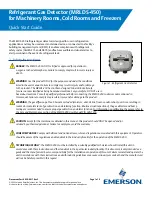
Document Part # 026-4417 Rev 2
Page 4 of 9
©2020 Emerson Retail Solutions, Inc. This document may be photocopied for personal use.
Visit our website at http://www.emerson.com for the latest technical documentation and updates.
•
Application:
the specifics of the application (possible leaks, air movement/draft, etc.) when selecting
a location.
•
Accessibility:
the degree of accessibility required for maintenance purposes when selecting a location.
•
Target Gas:
the specific gravity of the target gas when selecting the height of the instrument.
2. Using a 5/32” (4mm) hex key/allen wrench (not included), remove the lid and disconnect the ribbon cable from the base.
3. Set the lid and rubber gasket aside to be reinstalled later.
STEP 2: Wire Connections
WARNING:
Ensure that all wiring connections are made BEFORE applying power.
WARNING:
Relays are rated for 0 to 30V. DO NOT apply main power onto these relays.
IMPORTANT:
Cable glands are meant to accommodate one cable. DO NOT use cable glands for more than one cable.
IMPORTANT:
If analog output is 4 to 20mA, connect or short the connection to ensure the gas detector does not go into fault.
1. Locate connections (
Power, Analog, Modbus, Relays
) and remove terminal blocks from the PCBA.
2. Remove plugs from the corresponding M16 cable glands and pass the cable through the opening.
3. Secure wires in each terminal block and, pressing firmly, reinstall the terminal block in the PCBA.
4. Remove all excess cable from the housing before firmly securing the cable glands.
STEP 3: Reinstall Sensor and Connect Lid
CAUTION
: DO NOT leave excess cable inside of the gas detector housing. Failure to comply may result in damage to the product.
IMPORTANT:
To achieve proper seal in the IP66 enclosure, the lid screws should be torqued to 15 to 20 lbf in (1.5 to 2.0 Nm).
1. Reinstall the rubber gasket. Ensure that it is correctly seated by placing the side with two grooves face down and the edge
with two bumps on the top.
Figure 3 - Locate Connections
Figure 4 - Rubber Gasket Placement



























